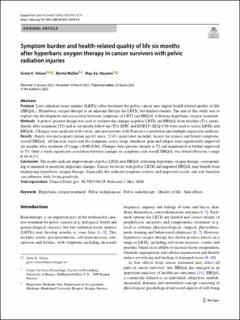Symptom burden and health‑related quality of life six months after hyperbaric oxygen therapy in cancer survivors with pelvic radiation injuries
Journal article, Peer reviewed
Published version

Åpne
Permanent lenke
https://hdl.handle.net/11250/3001709Utgivelsesdato
2022Metadata
Vis full innførselSamlinger
- Faculty of Psychology [523]
- Registrations from Cristin [9766]
Sammendrag
Purpose: Late radiation tissue injuries (LRTIs) after treatment for pelvic cancer may impair health related quality of life (HRQoL). Hyperbaric oxygen therapy is an adjuvant therapy for LRTIs, but limited studied. The aim of this study was to explore the development and association between symptoms of LRTI and HRQoL following hyperbaric oxygen treatment.
Methods: A pretest–posttest design was used to evaluate the changes in pelvic LRTIs and HRQoL from baseline (T1), immediately after treatment (T2) and at six-month follow-up (T3). EPIC and EORTC-QLQ-C30 were used to assess LRTIs and HRQoL. Changes were analysed with t-tests, and associations with Pearson’s correlation and multiple regression analyses.
Results: Ninety-five participants (mean age 65 years, 52.6% men) were included. Scores for urinary and bowel symptoms, overall HRQoL, all function scales and the symptoms scales sleep, diarrhoea, pain and fatigue were significantly improved six months after treatment (P-range = 0.00–0.04). Changes were present already at T2 and maintained or further improved to T3. Only a weak significant correlation between changes in symptoms and overall HRQoL was found (Pearson r-range 0.20–0.27).
Conclusion: The results indicate improvement of pelvic LRTIs and HRQoL following hyperbaric oxygen therapy, corresponding to minimal or moderate important changes. Cancer survivors with pelvic LRTIs and impaired HRQoL may benefit from undergoing hyperbaric oxygen therapy. Especially the reduced symptom-severity and improved social- and role function can influence daily living positively.
